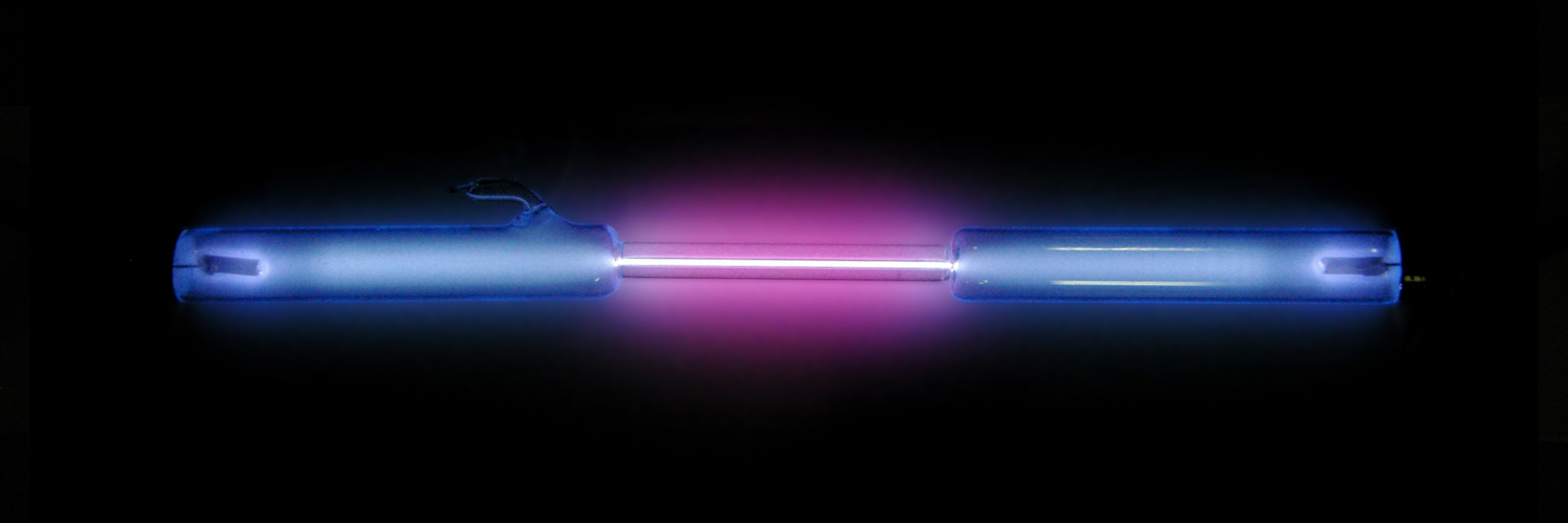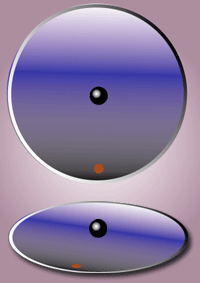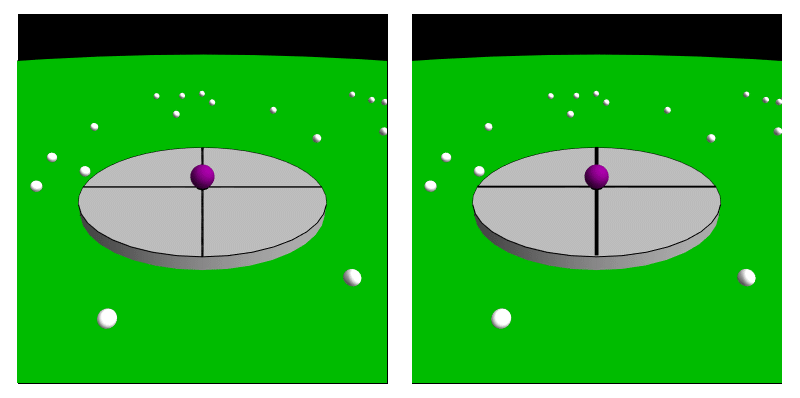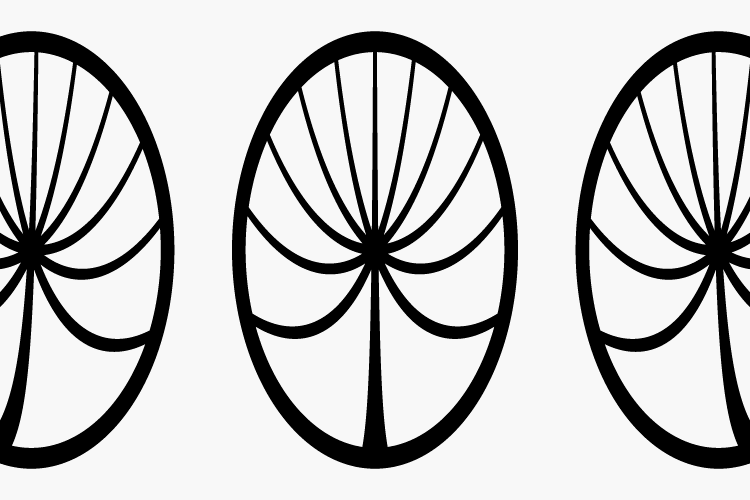|
Color Glass Condensate
Color-glass condensate (CGC) is a type of matter theorized to exist in atomic nuclei when they collide at near the speed of light. During such collision, one is sensitive to the gluons that have very small momenta, or more precisely a very small Bjorken scaling variable. The small momenta gluons dominate the description of the collision because their density is very large. This is because a high-momentum gluon is likely to split into smaller momentum gluons. When the gluon density becomes large enough, gluon-gluon recombination puts a limit on how large the gluon density can be. When gluon recombination balances gluon splitting, the density of gluons saturate, producing new and universal properties of hadronic matter. This state of saturated gluon matter is called the color-glass condensate. "Color" in the name "color-glass condensate" refers to a type of charge that quarks and gluons carry as a result of the strong nuclear force. The word "glass" is borrowed from the term for ... [...More Info...] [...Related Items...] OR: [Wikipedia] [Google] [Baidu] |
Matter
In classical physics and general chemistry, matter is any substance that has mass and takes up space by having volume. All everyday objects that can be touched are ultimately composed of atoms, which are made up of interacting subatomic particles. In everyday as well as scientific usage, ''matter'' generally includes atoms and anything made up of them, and any particles (or combination of particles) that act as if they have both rest mass and volume. However it does not include massless particles such as photons, or other energy phenomena or waves such as light or heat. Matter exists in various states (also known as phases). These include classical everyday phases such as solid, liquid, and gas – for example water exists as ice, liquid water, and gaseous steam – but other states are possible, including plasma, Bose–Einstein condensates, fermionic condensates, and quark–gluon plasma. Usually atoms can be imagined as a nucleus of protons and neu ... [...More Info...] [...Related Items...] OR: [Wikipedia] [Google] [Baidu] |
Compact Muon Solenoid
The Compact Muon Solenoid (CMS) experiment is one of two large general-purpose particle physics detectors built on the Large Hadron Collider (LHC) at CERN in Switzerland and France. The goal of the CMS experiment is to investigate a wide range of physics, including the search for the Higgs boson, extra dimensions, and particles that could make up dark matter. CMS is 21 metres long, 15 m in diameter, and weighs about 14,000 tonnes. Over 4,000 people, representing 206 scientific institutes and 47 countries, form the CMS collaboration who built and now operate the detector. It is located in a cavern at Cessy in France, just across the border from Geneva. In July 2012, along with ATLAS, CMS tentatively discovered the Higgs boson. By March 2013 its existence was confirmed. Background Recent collider experiments such as the now-dismantled Large Electron-Positron Collider and the newly renovated Large Hadron Collider (LHC) at CERN, as well as the () recently clos ... [...More Info...] [...Related Items...] OR: [Wikipedia] [Google] [Baidu] |
Coriolis Force
In physics, the Coriolis force is a pseudo force that acts on objects in motion within a frame of reference that rotates with respect to an inertial frame. In a reference frame with clockwise rotation, the force acts to the left of the motion of the object. In one with anticlockwise (or counterclockwise) rotation, the force acts to the right. Deflection of an object due to the Coriolis force is called the Coriolis effect. Though recognized previously by others, the mathematical expression for the Coriolis force appeared in an 1835 paper by French scientist Gaspard-Gustave de Coriolis, in connection with the theory of water wheels. Early in the 20th century, the term ''Coriolis force'' began to be used in connection with meteorology. Newton's laws of motion describe the motion of an object in an inertial (non-accelerating) frame of reference. When Newton's laws are transformed to a rotating frame of reference, the Coriolis and centrifugal accelerations appear. When applied ... [...More Info...] [...Related Items...] OR: [Wikipedia] [Google] [Baidu] |
Fictitious Force
A fictitious force, also known as an inertial force or pseudo-force, is a force that appears to act on an object when its motion is described or experienced from a non-inertial reference frame, non-inertial frame of reference. Unlike real forces, which result from physical interactions between objects, fictitious forces occur due to the acceleration of the observer’s frame of reference rather than any actual force acting on a body. These forces are necessary for describing motion correctly within an accelerating frame, ensuring that Newton's laws of motion#Second, Newton's second law of motion remains applicable. Common examples of fictitious forces include the centrifugal force, which appears to push objects outward in a rotating system; the Coriolis force, which affects moving objects in a rotating frame such as the Earth; and the Euler force, which arises when a rotating system changes its angular velocity. While these forces are not real in the sense of being caused by ph ... [...More Info...] [...Related Items...] OR: [Wikipedia] [Google] [Baidu] |
Lorentz Covariance
In relativistic physics, Lorentz symmetry or Lorentz invariance, named after the Dutch physicist Hendrik Lorentz, is an equivalence of observation or observational symmetry due to special relativity implying that the laws of physics stay the same for all observers that are moving with respect to one another within an inertial frame. It has also been described as "the feature of nature that says experimental results are independent of the orientation or the boost velocity of the laboratory through space". Lorentz covariance, a related concept, is a property of the underlying spacetime manifold. Lorentz covariance has two distinct, but closely related meanings: # A physical quantity is said to be Lorentz covariant if it transforms under a given representation of the Lorentz group. According to the representation theory of the Lorentz group, these quantities are built out of scalars, four-vectors, four-tensors, and spinors. In particular, a Lorentz covariant scalar (e.g., the s ... [...More Info...] [...Related Items...] OR: [Wikipedia] [Google] [Baidu] |
Frame Of Reference
In physics and astronomy, a frame of reference (or reference frame) is an abstract coordinate system, whose origin (mathematics), origin, orientation (geometry), orientation, and scale (geometry), scale have been specified in physical space. It is based on a set of reference points, defined as point (geometry), geometric points whose position (geometry), position is identified both mathematically (with numerical coordinate values) and physically (signaled by conventional markers). An important special case is that of ''inertial reference frames'', a stationary or uniformly moving frame. For ''n'' dimensions, reference points are sufficient to fully define a reference frame. Using Cartesian coordinate system, rectangular Cartesian coordinates, a reference frame may be defined with a reference point at the origin and a reference point at one unit distance along each of the ''n'' coordinate Cartesian coordinate system, axes. In Theory of relativity, Einsteinian relativity, referen ... [...More Info...] [...Related Items...] OR: [Wikipedia] [Google] [Baidu] |
Gluon
A gluon ( ) is a type of Massless particle, massless elementary particle that mediates the strong interaction between quarks, acting as the exchange particle for the interaction. Gluons are massless vector bosons, thereby having a Spin (physics), spin of 1. Through the strong interaction, gluons bind quarks into groups according to quantum chromodynamics, quantum chromodynamics (QCD), forming hadrons such as protons and neutrons. Gluons carry the color charge of the strong interaction, thereby participating in the strong interaction as well as mediating it. Because gluons carry the color charge, QCD is more difficult to analyze compared to quantum electrodynamics, quantum electrodynamics (QED) where the photon carries no electric charge. The term was coined by Murray Gell-Mann in 1962 for being similar to an adhesive or glue that keeps the nucleus together. Together with the quarks, these particles were referred to as Parton (particle physics), partons by Richard Feynman. P ... [...More Info...] [...Related Items...] OR: [Wikipedia] [Google] [Baidu] |
Motion (physics)
In physics, motion is when an object changes its position with respect to a reference point in a given time. Motion is mathematically described in terms of displacement, distance, velocity, acceleration, speed, and frame of reference to an observer, measuring the change in position of the body relative to that frame with a change in time. The branch of physics describing the motion of objects without reference to their cause is called ''kinematics'', while the branch studying forces and their effect on motion is called '' dynamics''. If an object is not in motion relative to a given frame of reference, it is said to be ''at rest'', ''motionless'', ''immobile'', '' stationary'', or to have a constant or time-invariant position with reference to its surroundings. Modern physics holds that, as there is no absolute frame of reference, Isaac Newton's concept of '' absolute motion'' cannot be determined. Everything in the universe can be considered to be in motion. Motion applies to ... [...More Info...] [...Related Items...] OR: [Wikipedia] [Google] [Baidu] |
Length Contraction
Length contraction is the phenomenon that a moving object's length is measured to be shorter than its proper length, which is the length as measured in the object's own rest frame. It is also known as Lorentz contraction or Lorentz–FitzGerald contraction (after Hendrik Lorentz and George Francis FitzGerald) and is usually only noticeable at a substantial fraction of the speed of light. Length contraction is only in the direction in which the body is travelling. For standard objects, this effect is negligible at everyday speeds, and can be ignored for all regular purposes, only becoming significant as the object approaches the speed of light relative to the observer. History Length contraction was postulated by George Francis FitzGerald, George FitzGerald (1889) and Hendrik Antoon Lorentz (1892) to explain the negative outcome of the Michelson–Morley experiment and to rescue the hypothesis of the stationary aether (Lorentz ether theory#Length contraction, Lorentz–FitzGerald ... [...More Info...] [...Related Items...] OR: [Wikipedia] [Google] [Baidu] |
Ions
An ion () is an atom or molecule with a net electrical charge. The charge of an electron is considered to be negative by convention and this charge is equal and opposite to the charge of a proton, which is considered to be positive by convention. The net charge of an ion is not zero because its total number of electrons is unequal to its total number of protons. A cation is a positively charged ion with fewer electrons than protons (e.g. K+ (potassium ion)) while an anion is a negatively charged ion with more electrons than protons (e.g. Cl− (chloride ion) and OH− (hydroxide ion)). Opposite electric charges are pulled towards one another by electrostatic force, so cations and anions attract each other and readily form ionic compounds. Ions consisting of only a single atom are termed ''monatomic ions'', ''atomic ions'' or ''simple ions'', while ions consisting of two or more atoms are termed polyatomic ions or ''molecular ions''. If only a + or − is present, it indicates ... [...More Info...] [...Related Items...] OR: [Wikipedia] [Google] [Baidu] |
Lead
Lead () is a chemical element; it has Chemical symbol, symbol Pb (from Latin ) and atomic number 82. It is a Heavy metal (elements), heavy metal that is density, denser than most common materials. Lead is Mohs scale, soft and Ductility, malleable, and also has a relatively low melting point. When freshly cut, lead is a shiny gray with a hint of blue. It tarnishes to a dull gray color when exposed to air. Lead has the highest atomic number of any stable nuclide, stable element and three of its isotopes are endpoints of major nuclear decay chains of heavier elements. Lead is a relatively unreactive post-transition metal. Its weak metallic character is illustrated by its Amphoterism, amphoteric nature; lead and lead oxides react with acids and base (chemistry), bases, and it tends to form covalent bonds. Lead compounds, Compounds of lead are usually found in the +2 oxidation state rather than the +4 state common with lighter members of the carbon group. Exceptions are mostly limited ... [...More Info...] [...Related Items...] OR: [Wikipedia] [Google] [Baidu] |






